Today’s post was written by a Swedish reader named Arne Bergkvist, about a very early Swedish automatic pistol I had not been aware of. It is particularly interesting as one of relatively few examples of self-loading firearms designed before the advent of smokeless powder. It never went into serial production, but shows plenty of ingenuity for its time. So without further ado, I’ll turn it over to Arne…
Swanström 1882 Automatic Pistol
by Arne Bergkvist
Carl Peter Swanström, born on 11 September, 1854 in Älvbacka parish just outside Karlskoga, the city where the BOFORS factory is located. Swanström was an employee from the early 1880s, first as a smith but later as foreman at the gun factory. An accident in the test department took his left arm, but the work with his automatic pistol was finished. Swanström had a grandson who immigrated to United States in the late 1920s and brought both a pistol and shotgun with him. In 1968 his widow got in contact with a well known gun collector and Luger-book author, Harry E. Jones from Torrance California. He purchased the pistol (as well as a shotgun made on the same principles), and the guns have been in the Jones family for 30-40 years now.
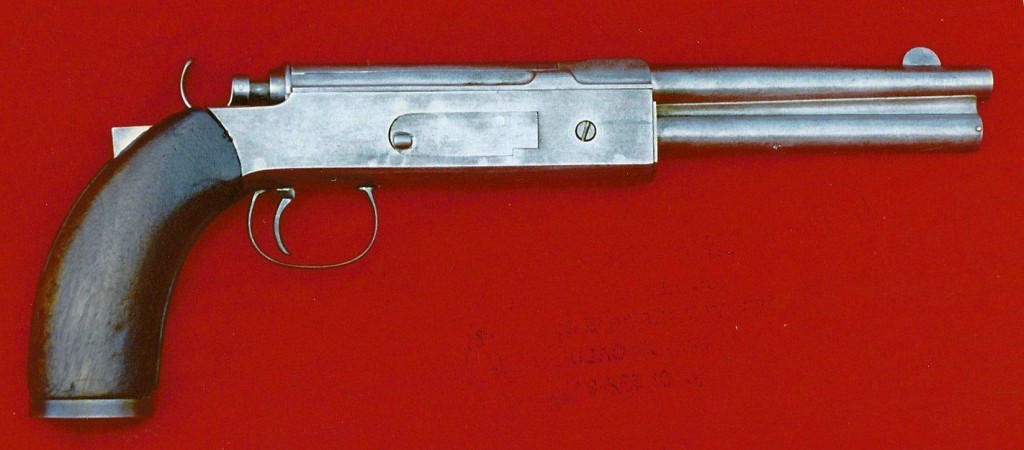
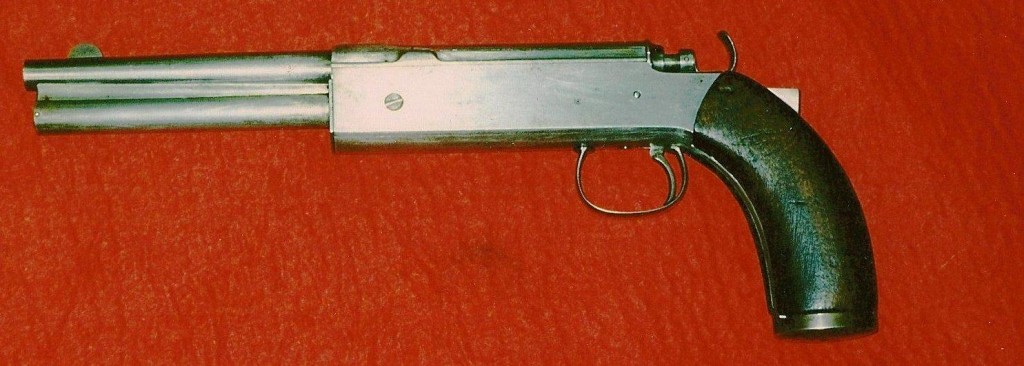
In 1999, when I for the first time could see and touch, both the pistol and the shotgun was Harry E. Jones not with us anymore. His son Mike Jones, at that time owned and maintained the collection. Harry E. Jones had under the time he owned the pistol, contacted the Army museum in Stockholm and done investigations about Swanström to get the proper information.
The Pistol
Extremely well done, handmade, with a short glance looking like a sawed of Winchester 92. The loading gate is similar as on Winchesters. The finish at the internal parts looks like a Swiss watch. By removing two screws you can divide the pistol in two parts, mechanism and grip.
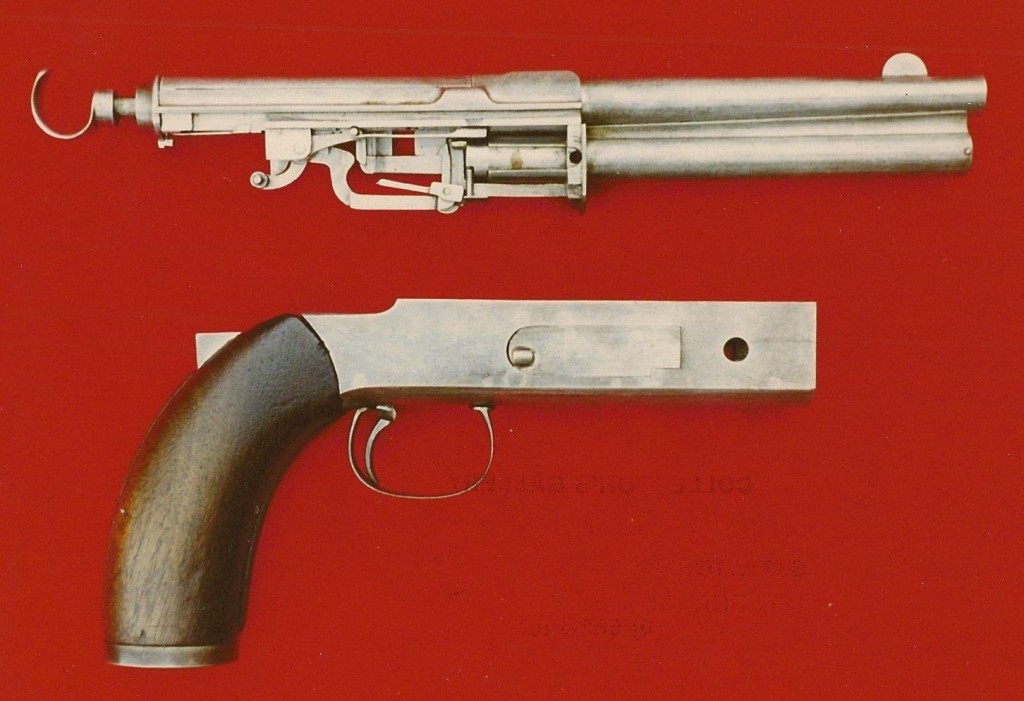
After divided in two parts you can continue the dismounting by taking out the magazine unit by pulling the magazine tube forward. Now the system is open for inspection and cleaning.
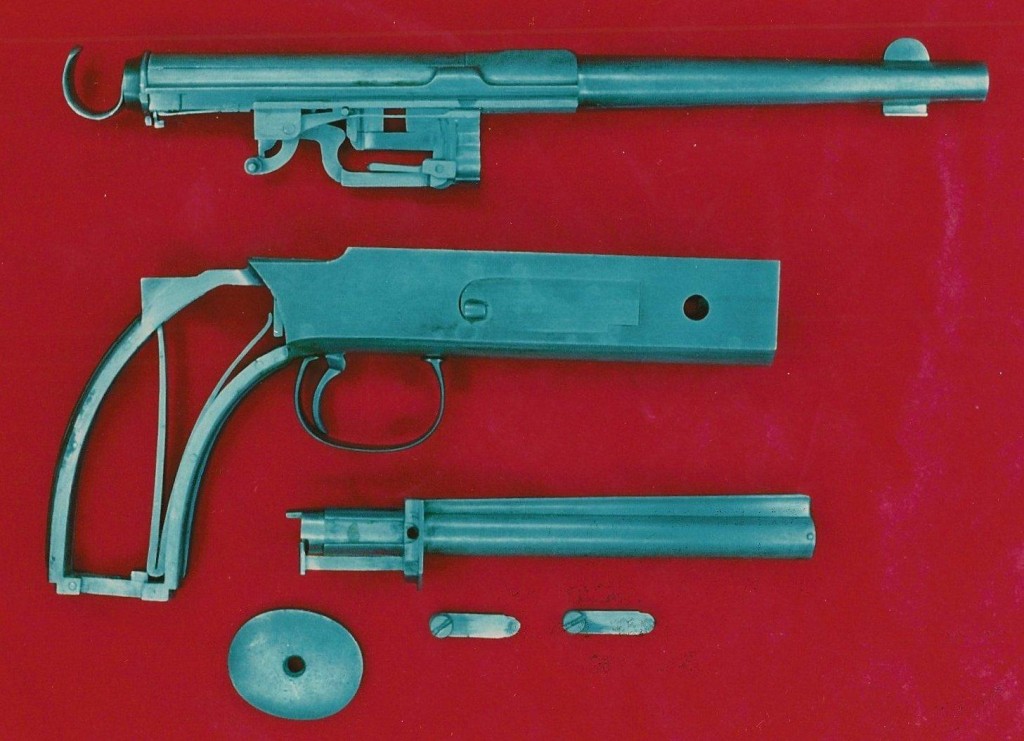
Instead of a hammer, the use of a striker take less space, and makes the mechanism behind the feeding elevator less bulky. The barrel-receiver unit will move backwards about 6.5 mm (1/4 inch) every time you pull the trigger. The bolt and barrel are locked together during this recoil by a pair of lever arms, which have square ends locking into the barrel assembly (the recesses in the bolt to fit them are located in the enlarged “bulbs” behind the chamber; see photo below) and round ends that lock into the bolt. Under the bolt on the picture below, you will see one of the locking levers. These levers are pushed open to release the bolt after recoil pushes the whole assembly back far enough. The striker is the “key” for opening the bolt. When striker passes the back part of the locking levers, they press out in the back and the hooks will fall deeper in to the bolt, unlocking from the barrel. After the front part of the levers open up the unit, the bolt continue backwards , throwing out the empty shell, picking up a new round from the elevator and is back in action again.
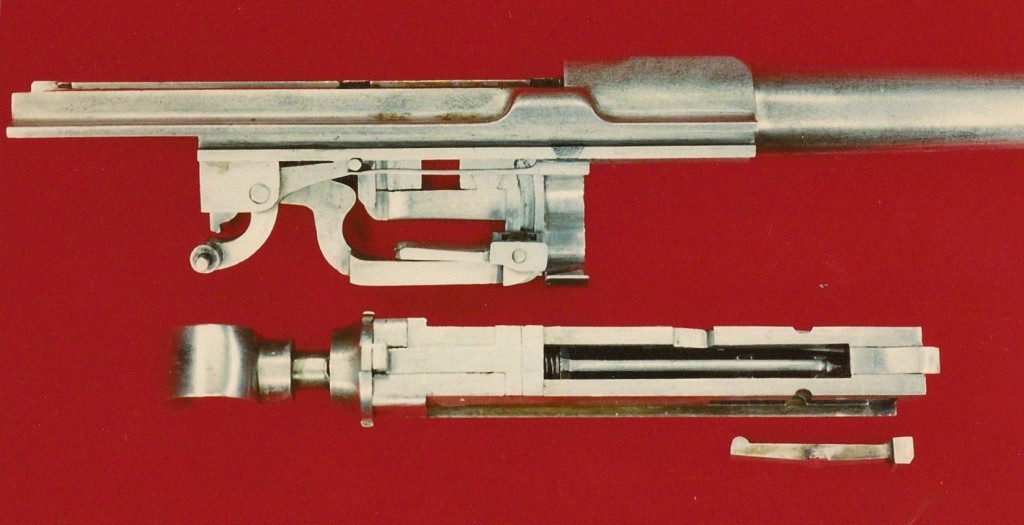
The receiver turned up-side-down. Here you can see the square opening for the recoil hooks next to the chamber. At the front of the bolt you can see the recoil hook mounted at the bolt.
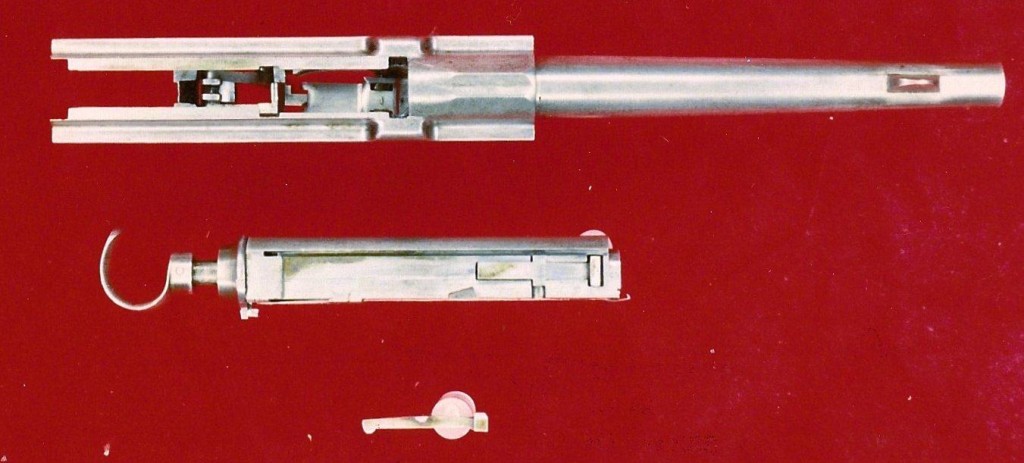
At the top of the receiver you can see the bulbs on each side of the bolt, just before the rear sight groove. The barrel is tapered with a steel front sight.

Technical Specs
Caliber: 7,5 mm Swiss ordnance 1882
Operating system: Short recoil
Locking system: Delayed blowback
Total length: 298 mm (11.75 in)
Total height 115 mm (4.5 in)
Barrel length 135 mm (5.3 in)
Magazine capacity:5 cartridges
Grips: Wood
Finnish: None; “in the white”
All pictures taken by Mike Jones, Torrance California USA


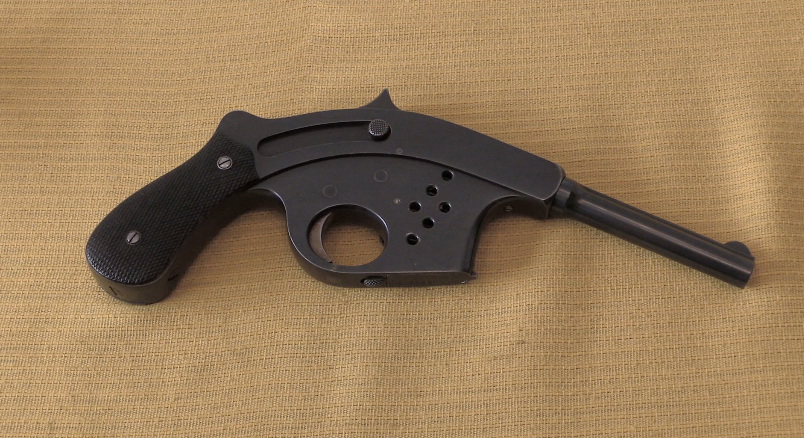
Tack så mycket!
Bit annoyed, thought I’d seen this design before and spent a good twenty minutes searching my (poorly organized) computer archives to find the pic I had and find it’s origins, turns out I was thinking of this: http://www.icollector.com/Unique-Prototype-Bolt-Action-Repeating-Pistol_i9752166 which beyond the basic shape is something completely different.
Wonderful piece of information!
Is there any evidence that dates to gun to 1882 (what would be extremely early, a decade ahead of the Bergmann) or does the name only refer to the cartridge?
“Repeating” pistols built along these lines were made in Europe in that time period (1880s). Most were tube-magazine lever-actions, or used a moving trigger-guard to operate a mechanism similar to the Gaulois (rising block-type magazine) or a form of revolver-type action (the P.H. Counet patent).
The Clair brothers’ patent showed a weapon that resembled this one externally, but had a curved tubular magazine housed in the pistol grip. Its under-barrel tube housed the gas-piston assembly.
This weapon falls into the “transitional” category between the magazine repeater and the true self-loader. So yes, I believe it could in fact date to the early 1880s.
cheers
eon
Amazing…as rare as they come. Like Maxim’s and John Browning’s early attempts at self-loading rifles, the Winchester lever guns seem to be the inspiration for, if not the basis for the arm. I would love to see someone fire a few rounds through it (and would gladly volunteer to try it out) and see if it is a viable design. I’ve often read that the Schoenberger-Laumann was the first self-loading pistol to reach the production stage, but one wonders how many “one-off” prototypes were made around this time, as the new “smokeless powder” made the self-loading firearm a truly workable concept. Slightly OT, this will give me something else to show a colleague who believes that auto-loading firearms are a recent invention, as in the last 50 years (and should be outlawed).
Hm. That would mean 1960s. You could ask him if he thinks both World Wars and Korea were fought with Spencer repeaters, Trapdoor Springfields, and Gatling Guns, but that might strain his brain a bit too much.
cheers
eon
“He” is actually a “she,” and yes, one of the shocking things I’ve discovered in academia (I became a professor later in life after a successful career in the oilfield) is the lack of knowledge some of my colleagues possess outside of their narrow and specialized fields. Don’t get me wrong, I work with a number of very knowledgeable and interesting people, but there are a few who fill a specific niche and aren’t capable of doing anything else. BTW, she wouldn’t know a bolt-action rifle from a bolt of fabric!
If you wanted to be really snarky, you could ask her if she thinks that the sewing machine was also invented after WW2… My grandmother had a pedal-powered Singer from the 1920s and my grandfather had a slightly later Baby Browning. Never got to to shoot that one, unfortunately. In actuality the first predecessors of modern sewing machines predate self-loading pistols by several decades, but the analogy is still valid.
“to see someone fire a few rounds through it”
The fact that this firearm uses Swiss Ordnance cartridge draw my attention. It implies some connection with Swiss Forces. I think it may be designated to be competitor to Swiss 1882 revolver, do have anybody of you information about the trials that lead to choice the Modele 1882 revolver in Switzerland, especially the competitors?
Fascinating piece of history. I had no idea this auto-loader existed. Thanks for posting!
Beautiful pistol, and a black-powder self-loader at that…wow! Oh, Doc & Eon? The great science-fiction author Robert Heinlein said it best: “Never try to teach a pig to sing. It wastes your time and annoys the pig.”
So far I know the earliest self-loading pistol was LUCE 1874 pistol. It was patented in USA as a patent US156431A link: http://www.google.com/patents/US156431
Notice the box-magazine in grip like in modern automatic pistols. I don’t know that it was produced or not. Did the US Patent Office require working model to grant patent?
At that time, yes. After about 1920, the working model requirement was dropped except for one exception. The USPO still requires a working model for any application for a patent on a perpetual-motion device. Seriously.
As for the Luce patent, it seems to be a blow-forward system similar to the Japanese Hino-Komuro of 1904-1908;
http://www.google.com/patents/US886211
The major difference being that the Luce has an actual hammer that sears off the trigger, while the Hino-Komuro was a fixed-firing-pin “slamfire” design.
The hammer searage looks very like that of the early Krnka-Roth autoloader of 1895, and the Frommer pistols of 1906 and 1910.
The resemblance is probably a coincidence due to the requirement of fitting the action into a roughly equivalent shape and size of volume in the frame. Sort of the way a Spitfire, P-51B, and Bf-109 looked a lot alike; there are only so many ways to do a given job under the constraints of aerodynamics or small-arms design.
cheers
eon
Externally, it looks like a Volcanic Repeater, only without the lever-action trigger guard.
Daweo, I have never seen a reference to a sale or a collector’s example of the Luce pistol, nor have I encountered anyone who has. Also, in reading over the patent statements, Luce doesn’t make any reference to the pistol being an autoloader, and from the patent language it seems most likely to be a repeating pistol of some sort, rather than a self-loading firearm, due to the lack of any mention of an auto-loading capability. As to a working model, I believe it was a necessity in order to file a U.S. Patent up to 1880, so there was probably some version in existence, if only to illustrate the features of the mechanism, even if it was incapable of actually firing (many patents are based on reduced-scale models/samples that illustrate the working principles w/o actually being capable of practical or sustained use). So, it is possible that there is at least one example in existence, somewhere, and if I should ever be so lucky as to get my hands on it, I’ll make sure to post it here, first.
It could have been a variant of the “gravity-feed” pistol, a European gadget using Volcanic-type ammunition, that had a tubular magazine and was reloaded by pointing the muzzle up with the hammer at half-cock; one of these is illustrated on p. 255 of the NRA reprint edition of Firearms Curiosa by Winant.
More recently, the Semmerling LM-4 pocket pistol in .45 ACP, a manual repeater with an action very like a “blow-forward”, could be reloaded one-handed by simply snapping the wrist downward hard, causing the barrel to be slammed forward by centrifugal force in the arc. Its return spring would attend to returning the barrel to battery, scooping a fresh round out of its magazine and chambering it as it went.
Of course, the small drawback to such gadgetry is what the thief or footpad you’re up against, and/or his friends, are getting up to while you, the intended vic, are preoccupied with all these gymnastics.
I still maintain that a compact revolver in a serious caliber is hard to beat. Now, or in the 1880s.
cheers
eon
Semmerling made a derringer type handgun, in the Lancaster pistol configuration previously apparently i.e. Four barrels, break top – .357 Mag, I am not sure the Lm4 offers much benefit over that model personally, an extra round… .45acp, offset by the impracticality of the reloading method given it’s supposed to be a close range pistol – wrist action aside. A model using the trigger guard to cycle the action rearwards more conventionally might have been more practical in conjunction with a similar trigger operated locking mechanism.
Or they might not have done, but I think the Lancaster pistol configuration is probably better for the role if slightly heavier, bulkier.
Is there any locked action blow forward pistols, the Pancor Jackhammer was blow forward apparently how did that lock?
Sort of flapper locked…
After examining the patent drawings of the Luce pistol (with the aid of a really nice bottle of bourbon), it appears that the action is a sort of hammer-actuated rolling block repeater. The block appears to open as the hammer is cocked, allowing the cartridge from the magazine to align with the breech, then the hammer falls forward with the breechblock and loads and fires the cartridge in a single motion. Whether the system requires a manually re-cocked hammer or is opened and cocked by recoil is not mentioned in the patent, but the only two springs visible in the drawings seem to be the leaf-type mainspring acting on both the hammer and the breechblock, and the magazine spring. It appears to be a simple yet functional design, and could function as an early self-loader given enough of a recoil impulse. Mr. Luce was definitely on to something new and possibly revolutionary, but given a choice back then, I would probably have stuck with a Colt Peacemaker, Remington 1875, or Smith and Wesson No. 3 (or a Webley for our English friends).
Eon, as a young man I had the dubious pleasure of firing a Semmerling that belonged to a friend’s father. I recall it had a horrid trigger pull, and I had to work the slide forward and back for each shot with my digits precariously close to the muzzle. It would only feed 230 grain hardball ammo (no hollowpoints). The owner justified the purchase because he wanted something compact that could shoot .45 ACP, and that with a .45, he’d only need one shot. 🙂
Pdb, I believe you are referring to the COP (Compact Off-Duty Police) pistol in .357 Magnum. It was a 4-barreled abomination that wasn’t very compact or accurate. I believe both the Semmerling and the COP are still in limited production (or were until recently) by the American Derringer Corp. in Waco Texas.
I’m not so sure about the chambering. It’s probably chambered for 7.5mm Swedish, since that round was used in the Swedish M1887 Nagant. It shares the same dimensions as 7.5 Swiss, and could easily be mistaken for it.
As regarding the shotgun, it would be interesting to hear what distance ınventor used “Short Recoiling”, since a shotgun sized firearm needed rather long recoiling travel for either managing the shot’s bore out, or slowing the
violent backward thrust coming from big momentum gained.
swede1986, remember that in 1882 was not the swedish round m/87 on the market. I was self in doubt about the cartridge used, but after some calculation (without Bourbon)I come to the conclusion that the recoil power is about the same as 32 ACP, so it is possible.
Anyway, I heard about this pistol for many years ago, when Armémuseum in Stockholm got the offer to buy it, and one day I went over to Torrance California to se… and hold on to it. Amazing !!!
And there is more to it, I am sharpening the pencil.